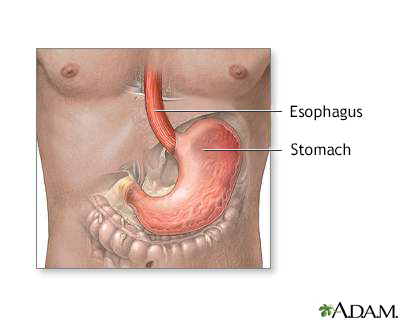Bernstein test
Definition
The Bernstein test is a method to reproduce symptoms of heartburn. It is most often done with other tests to measure esophageal function.
Alternative Names
Acid perfusion test
How the Test is Performed
The test is done in a gastroenterology laboratory. A nasogastric (NG) tube is passed through one side of your nose and into your esophagus. Mild hydrochloric acid will be sent down the tube, followed by salt water (saline) solution. This process may be repeated several times.
You will be asked to tell the health care team about any pain or discomfort you have during the test.
How to Prepare for the Test
You will be asked not to eat or drink anything for 8 hours before the test.
How the Test will Feel
You may have a gagging feeling and some discomfort when the tube is put in place. The acid may cause symptoms of heartburn. Your throat may be sore after the test.
Why the Test is Performed
The test tries to reproduce symptoms of gastroesophageal reflux (stomach acids coming back up into the esophagus). It is done to see if you have the condition.
Normal Results
The test results will be negative [no symptoms of gastroesophageal reflux disease (GERD)].
What Abnormal Results Mean
A positive test shows that your symptoms are caused by esophageal reflux of acid from the stomach.
Risks
There is a risk of gagging or vomiting.
Gallery

References
Bremner RM, Mittal SK. Esophageal symptoms and selection of diagnostic tests. In: Yeo CJ, ed. Shackelford's Surgery of the Alimentary Tract. 8th ed. Philadelphia, PA: Elsevier; 2019:chap 5.
Kavitt RT, Vaezi MF. Diseases of the esophagus. In: Flint PW, Francis HW, Haughey BH, et al, eds. Cummings Otolaryngology: Head and Neck Surgery. 7th ed. Philadelphia, PA: Elsevier; 2021:chap 68.
Pandolfino JE, Kahrilas PJ. Esophageal neuromuscular function and motility disorders. In: Feldman M, Friedman LS, Brandt LJ, eds. Sleisenger and Fordtran's Gastrointestinal and Liver Disease. 11th ed. Philadelphia, PA: Elsevier; 2021:chap 44.